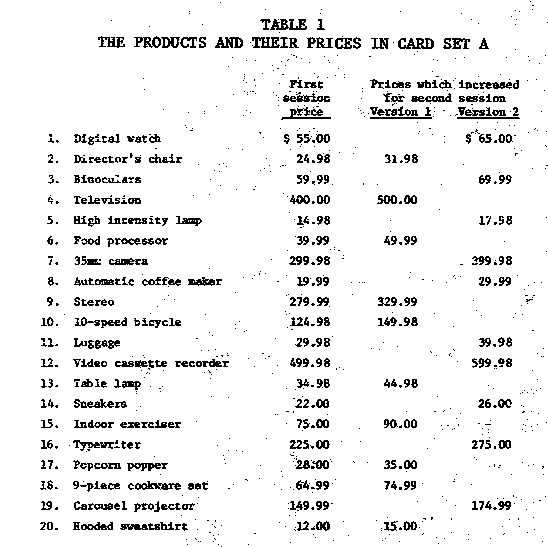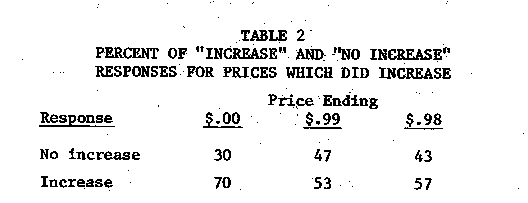Introduction
This research paper explores the different between odd and even price endings. The treatise attempts to reveal the perception of customers as indicated in different literature and whether these perceptions may be related to several past researches on consumer behavior. The paper will address the existing realms and contribution of different literature to the current position of the research topic. It is apparent that consumers of low-end and high-end goods are directly influenced by different price endings. Besides, the impact of the odd and even pricing may be related to price interest and personal involvement, which controls the perception of different customers.
Research questions
- How do price endings of goods persuade customers’ perceptions?
- How sensitive are the highly involved customers to the perceptional effects as a result of price endings as compared to the less involved customers?
- How do prices that end in 9 magnetize price- interested customers in a higher proportion than the customers who are least interested in price?
Research objectives
Since this research paper attempts to review the differences between even and odd pricing, the primary objectives will be;
- To establish the perceptions of customers towards products with odd and even price endings.
- To establish the quantifiable differences between odd and even pricing.
- To establish the possible reasons for the differences between the odd and even pricing.
Specific price format
The past literature indicates that several factors moderate the influence of odd pricing. This study will only concentrate on price interest and personal involvement by the consumers. As indicated by Baumeister, Sparks, Stillman, and Vohs (2008), consumers who are highly involved relate the different pricing mechanism to the quality of a good or service (Baumeister, Sparks, Stillman, and Vohs 9). However, the less involved customers would prefer to associate with a price they perceive as cheaper.
Literature on price dispersion gives an insight into different heterogeneities for odd and even pricing. It is important to set a specific price format since businesses have the primary goals of price discrimination, product segmentation, and maintaining the competitive advantage. The past literature in price formatting suggests that price formats are chosen by companies to attract particular customers and position such a product in the market. For instance, prices that end in 9 (odd pricing) such as $4.99 or $4.59 have the potential of creating a price image in the minds of customers. The price image is that the product or service in cheaper. This fulfils the promotional and everyday low price (EDLP) formats (Kleinsser and Wagner 59).
On the other hand, use of even pricing may be advantageous or disadvantageous, depending on the targeted customer. For instance, the high economic-end customer would not consider price image as the determinant factor in purchasing. Rather, the higher the price of a product, the higher the chances of product intake since the mind of such a customer will create a perception of quality. However, even pricing may not auger well with the low economic-end customer since the perceived price image would be the expensive tag (Marylyn and Attalla 570).
Experiment
In order to establish the differences between odd and even pricing, the research adopted qualitative research with the use of primary data. A sample of 27 students was randomly chosen besides 20 different products. The prices were presented as odd and even as listed in the table below.

Setup
As the study commenced, the respondents were informed of their participation in the research aimed at reviewing of shopping behavior. The respondents were requested specify their eagerness to buy the products which were interchanged for each product. The same procedure was repeated for all the products. Another parallel card labeled B was created out of card A. Some of the prices were slightly increased in card B. The respondents were then requested to note whether the new prices were higher or the same as the old prices in card A. The respondents were then informed to rate the integrity of their judgment on a five-point scale (number five means very sure while number 1 means not sure). The same procedure was repeated for card B.
Support theory
According to Michael, Flynn, and Helion (2013), good pricing policies are vital for the attainment of progress in both economic and social spheres. Price policy formulation; thus, is central to success of any business enterprise and more often the quality of price policies formed is depended on the capacity of the marketing team in the business and the strategies employed by the team (Michael, Flynn, and Helion 99). Before making any price policies, it is important for the firm to carry out research on the factors affecting pricing; both internal and external. Furthermore, the pricing policy should compare all the available pricing options and result in an acceptable price level range for the products. Marylyn and Attalla (2001) note that performing prior research to determine most appropriate pricing strategies is important as the knowledge acquired can be used in assigning the best price markups for the products (Marylyn and Attalla 570).
Findings
The responses for the first session (card A) were calculated for the odd and even price endings. The ANOVA analysis showed that there was little difference between the odd and even pricing. The ANOVA analysis had similar results for card A and card B. This is summarized in the table below.

Several pricing strategies exist for companies to choose from, however, some of these pricing strategies only work well with certain pricing objectives. Thus, careful selection ought to be done by business managers when choosing a pricing objective as the choice of appropriate pricing strategies depends on the selected pricing objective. Moreover, each pricing objective works well with a particular set of pricing strategies. Different pricing strategies can be successfully applied at different times to fit the changing market strategies, product life cycles, and market conditions (Marylyn and Attalla 570). From the above findings, it is apparent that products with odd price endings tend to create a ‘cheaper’ price image among the low economic end customers. However, the same cheaper price image makes such products unpopular among the high economic end customers who associated quality with higher price.
Conclusion
It is apparent that odd and even price endings have significant behavioral influence among customers interested in certain products. The difference is as a result of the price image as perceived by a customer. Products with odd price endings tend to attract more of the low economic end customers than products with even price endings when all other factors are held constant. Basically, the odd price ending creates an image of a more affordable price than the even price ending.
Works Cited
Baumeister, Roy, Erin Sparks, Tyler Stillman, and Kathleen Vohs. “Free will in consumer behavior: Self-control, ego depletion, and choice.” Journal of Consumer Psychology 18.2 (2008): 4-13. Print.
Kleinsser, Sabine and U. Wagner. “Price endings and tourism consumers’ price perceptions”. Journal of Retailing and Consumer Services 18.1 (2011): 58-63. Print.
Marylyn, Carrigan and A. Attalla. “The myth of the ethical consumer-do ethics latter in purchase behavior”, Journal of consumer marketing 18.7 (2001): 560-578. Print.
Michael, Lynn, Sean Flynn, and Chelsea Helion. “Do customers prefer round prices? Evidence from pay-what-you-want decisions and self-pumped gasoline purchases.” Journal of Economic Psychology 36.1 (2013): 96-102. Print.